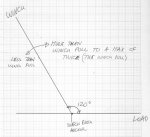A couple of you guys are scaring me a bit...
The block does not care who is moving, what is fixed, or why you hooked it up in the first place. The reaction force on the hook of the snatch block will be the vector sum of the two forces applied, which is the line going in, and the line going out. ALWAYS. It does not matter what is hooked where. Even if you are working on a 1:1 rig, gaining no advantage. The force on the block is the sum of the two parts of the line and may range from zero force at all to twice the force applied by the winch, depending on the angle involved. Not what's moving or what isn't moving.
Don't want to figure vector sums... In previous posts you'll find the information in chart form. There is also a good "cheat" since in all practicality most people will have one size of snatch block to choose from, and a select few might keep two on hand, you need only remember one number. 120 degrees between the line in and the line out is the magic number where all three forces (the cable in, the cable out, and the snatch block hook) all three receive equal forces, and are angled equally from each other. If the cable's angle is equal to or wider than 120 degrees from each other (less sharp of a bend in the cable), then it is safe to use a block that supports the winch's maxumum pull and you will always be covered, but that is the maximum. If the two cables are closer than 120 degrees (sharper bend in the cable), use a block that supports twice the winch's pull. You can always use a block that's too big...
Again, the snatch block does not care what you are doing. The reaction on the block's hook is force from the line in plus the force from the line out. Period.



